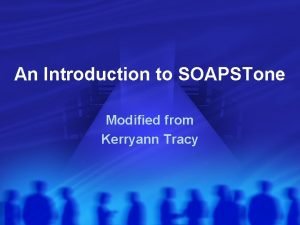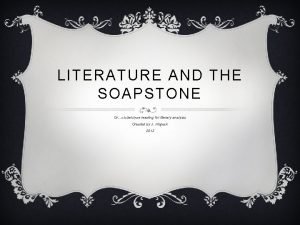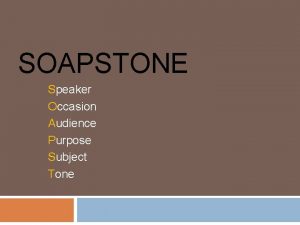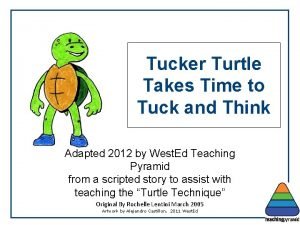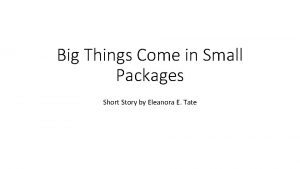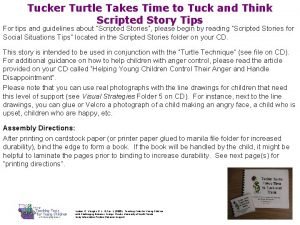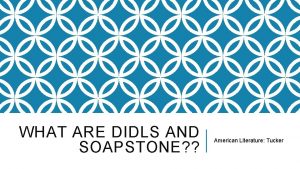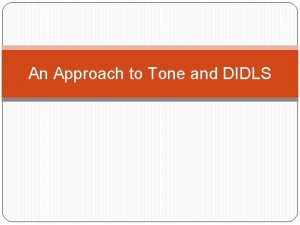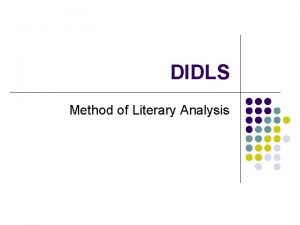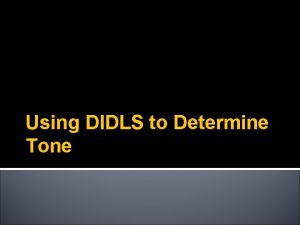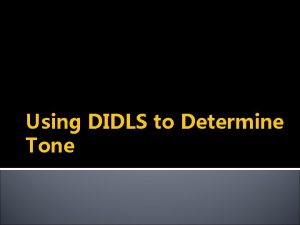WHAT ARE DIDLS AND SOAPSTONE American Literature Tucker









- Slides: 9

WHAT ARE DIDLS AND SOAPSTONE? ? American Literature: Tucker

DIDLES Diction--the connotation of word choice Images--vivid appeals to understanding through the senses Details--facts that are included or those omitted Language--the overall characteristics of the body of words used: formal, clinical Syntax and Structure--how structure affects the reader's attitude (e. g. , short sentences are often emotional or assertive and longer sentences move toward more reasonable or scholarly intent); how the piece is structured: Chronological order; flashback; memory; conversation/dialogue; plot; setting

WHAT IS DICTION? Diction is word choice. What words do authors choose to convey the meaning that they want to convey? How does word choice help create mood/tone? v. Words can be concrete (specific) or abstract (general or conceptual). v. Words can be mainly denotative (containing an exact meaning, e. g. , dress) or connotative (containing a suggested meaning, e. g. , gown) v. Words can be euphonious (pleasant sounding, e. g. , languid, murmur) or cacophonous (harsh sounding, e. g. , raucous, croak).

WHAT IS IMAGERY? ? Imagery is when words create a picture in the reader’s mind. It includes: ØFigurative language: simile, metaphor, personification, alliteration, etc. When reading a piece containing imagery, you need to ask yourself two questions: 1. What do I hear, taste, smell, or feel? 2. What effect is the author trying to convey with these messages?

"I suppose hobbits need some description nowadays, since they have become rare and shy of the Big People, as they call us. They are (or were) a little people, about half our height, and smaller than the bearded Dwarves. Hobbits have no beards. There is little or no magic about them, except the ordinary everyday sort which allows them to disappear quietly and quickly when large stupid folk like you and me come blundering along, making a noise like elephants which they can hear a mile off. They are inclined to be fat in the stomach; they dress in bright colours (chiefly green and yellow); wear no shoes, because their feet grow naturally leathery soles and thick warm brown hair like the stuff on their heads (which is curly); have long clever brown fingers, good-natured faces, and laugh deep fruity laughs (especially after dinner, which they have twice a day when they can get it). Now you know enough to go on with. " WHAT ARE DETAILS? Details: The facts given by the author or speaker as support for the attitude or tone. The speaker's perspective shapes what details are given. Look at the following passage from Tolkien's The Hobbit. Notice that the speaker's attitude toward the hobbits is revealed in whimsical and complimentary details:

WHAT IS LANGUAGE? q. Formal Language (polysyllabic words) q. Neutral language (simple words) q. Low, Informal Language (slang, everyday language) Types include: o. Slang: informal, recently formed words/phrases (“Yo, dawg! What up? ”) o. Colloquialisms: Figures of speech, expressions (“Reading Into the Wild was worth ruining my eyes”) o. Jargon: Characteristic of a trade, profession, pursuit ( o. Dialect: language characteristic of a region, place (“I love soda pop”; “Ain’t never seen that”)

SYNTAX AND STRUCTURE Syntax is Sentence Structure! Long, flowing sentences give the reader a different feeling than short, choppy sentences. Think about the following: ØSentence length (How many long sentences? How many short sentences? ) ØKinds of Sentences (declarative, interrogative, imperative, exclamatory, simple, compound, complex, compound-complex) ØOrder of the Sentence (ex: inverted: “happy you are”) ØAlso consider: § Juxtaposition: a poetic and rhetorical device in which naturally unassociated ideas, words, or phrases are placed next to each other § Parallel structure: a grammatical or structural similarity between sentences or parts of a sentence § Repetition: key words and phrases are repeated for effect.

WHAT IS SOAPSTONE? Subject: What is the text about? Occasion: Where and when did the story/poem take place? Audience: Toward whom is the text directed? Purpose: What is the reason the text was written? Speaker: The voice in the story. Is it male, female? Old/young? Educated, uneducated? Tone: What is the author’s attitude toward the subject? What emotions are evoked?

SOAPSTONE EXAMPLE: From “Still I Rise” by Maya Angelou Out of the huts of history’s shame I rise Up from the past that’s rooted in pain I rise I’m a black ocean, leaping and wide Welling and swelling I bear the tide. Leaving behind nights of terror and fear I rise Into a daybreak that’s wondrously clear I rise I am the dream and the hope of the slave I rise.




